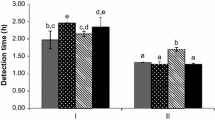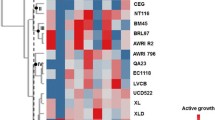Abstract
Grape juice contains about equal amounts of glucose and fructose, but wine strains of Saccharomyces cerevisiae ferment glucose slightly faster than fructose, leading to fructose concentrations that exceed glucose concentrations in the fermenting must. A high fructose/glucose ratio may contribute to sluggish and stuck fermentations, a major problem in the global wine industry. We evaluated wine yeast strains with different glucose and fructose consumption rates to show that a lower glucose preference correlates with a higher fructose/glucose phosphorylation ratio in cell extracts and a lower K m for both sugars. Hxk1 has a threefold higher V max with fructose than with glucose, whereas Hxk2 has only a slightly higher V max with glucose than with fructose. Overexpression of HXK1 in a laboratory strain of S. cerevisiae (W303–1A) accelerated fructose consumption more than glucose consumption, but overexpression in a wine yeast strain (VIN13) reduced fructose consumption less than glucose consumption. Results with laboratory strains expressing a single kinase showed that total hexokinase activity is inversely correlated with the glucose/fructose (G/F) discrepancy. The latter has been defined as the difference between the rate of glucose and fructose fermentation. We conclude that the G/F discrepancy in wine yeast strains correlates with the kinetic properties of hexokinase-mediated sugar phosphorylation. A higher fructose/glucose phosphorylation ratio and a lower K m might serve as markers in selection and breeding of wine yeast strains with a lower tendency for sluggish fructose fermentation.


Similar content being viewed by others
References
Ausubel FM (1994) Current protocols in molecular biology. Wiley, New York
Bauer FF, Pretorius IS (2000) Yeast stress response and fermentation efficiency: how to survive the making of wine - A review. S Afr J Enol Vitic 21:27–51
Bernard EA (1975) Hexokinases from yeast. Methods Enzymol 42:6–20
Berthels NJ, Cordero Otero RR, Bauer FF, Thevelein JM, Pretorius IS (2004) Discrepancy in glucose and fructose utilisation during fermentation by Saccharomyces cerevisiae wine yeast strains. FEMS Yeast Res 4:683–689
Bisson LF (1999) Stuck and sluggish fermentations. Am J Enol Vitic 50:107–119
Blazquez MA, Lagunas R, Gancedo C, Gancedo JM (1993) Trehalose-6-phosphate, a new regulator of yeast glycolysis that inhibits hexokinases. FEBS Lett 329:51–54
Boulton RB, Singleton VL, Bisson LF, Kunkee RE (1996) Yeast and biochemistry of ethanol fermentation. In: Boulton RB, Singleton VL, Bisson LF, Kunkee RE (eds) Principles and practices of winemaking. Chapman and Hall, New York, pp 139–172
Bradford MM (1976) A rapid and sensitive method for the quantitation of microgram quantities of protein utilizing the principle of protein-dye binding. Anal Biochem 72:248–254
De Winde JH, Crauwels M, Hohmann S, Thevelein JM, Winderickx J (1996) Differential requirement of the yeast sugar kinases for sugar sensing in establishing the catabolite-repressed state. Eur J Biochem 241:633–643
Entian KD, Mecke D (1982) Genetic evidence for a role of hexokinase isozyme PII in carbon catabolite repression in Saccharomyces cerevisiae. J Biol Chem 257:870–874
Entian KD, Barnett JA (1992) Regulation of sugar utilization by Saccharomyces cerevisiae. Trends Biochem Sci 17:506–510
Ernandes JR, De Meirsman C, Rolland F, Winderickx J, de Winde J, Brandao RL, Thevelein JM (1998) During the initiation of fermentation overexpression of hexokinase PII in yeast transiently causes a similar deregulation of glycolysis as deletion of Tps1. Yeast 14:255–269
Fleet GH (1998) The microbiology of alcoholic beverages. In: Wood BJB (ed) Microbiology of fermented foods. Blackie, Glasgow, pp 217–262
Gafner J, Schütz M (1996) Impact of glucose–fructose-ratio on stuck fermentations: practical experiences to restart stuck fermentations. Vitic Enol Sci 51:214–218
Gietz RD, Schiestl RH, Willems AR, Woods RA (1995) Studies on the transformation of intact yeast cells by the LiAc/SS-DNA/PEG procedure. Yeast 11:355–360
Guillaume C, Delobel P, Sablayrolles JM, Blondin B (2007) Molecular basis of fructose utilization by the wine yeast Saccharomyces cerevisiae: a mutated HXT3 allele enhances fructose fermentation. Appl Environ Microbiol 73:2432–2439
Hohmann S, Winderickx J, de Winde JH, Valckx D, Cobbaert P, Luyten K, De Meirsman C, Ramos J, Thevelein JM (1999) Novel alleles of yeast hexokinase PII with distinct effects on catalytic activity and catabolite repression of SUC2. Microbiology 145:703–714
Lee CK (1987) The chemistry and biochemistry of the sweetness of sugars. Adv Carbohydr Chem Biochem 45:199–351
Lilly M, Bauer FF, Lambrechts MG, Swiegers JH, Cozzolino D, Pretorius IS (2006a) The effect of increased yeast alcohol acetyltransferase and esterase activity on the flavour profiles of wine and distillates. Yeast 23:641–659
Lilly M, Bauer FF, Styger G, Lambrechts MG, Pretorius IS (2006b) The effect of increased branched-chain amino acid transaminase activity in yeast on the production of higher alcohols and on the flavour profiles of wine and distillates. FEMS Yeast Res 6:726–743
Olesen K, Franke Johannesen P, Hoffmann L, Bech Sorensen S, Gjermansen C, Hansen J (2000) The pYC plasmids, a series of cassette-based yeast plasmid vectors providing means of counter-selection. Yeast 16:1035–1043
Özcan S, Johnston M (1999) Function and regulation of yeast hexose transporters. Microbiol Mol Biol Rev 63:554–569
Perez M, Luyten K, Michel R, Riou C, Blondin B (2005) Analysis of Saccharomyces cerevisiae hexose carrier expression during wine fermentation: both low- and high-affinity Hxt transporters are expressed. FEMS Yeast Res 5:351–361
Salmon JM (1989) Effect of sugar transport inactivation in Saccharomyces cerevisiae on sluggish and stuck enological fermentations. Appl Environ Microbiol 55:953–958
Salmon JM, Vincent O, Mauricio JC, Bely M, Barre P (1993) Sugar transport inhibition and apparent loss of activity in Saccharomyces cerevisiae as a major limiting factor of enological fermentations. Am J Enol Vitic 44:56–64
Sambrook J, Fritsch EF, Maniatis T (1989) Molecular cloning: a laboratory manual, 2 edn. Cold Spring Harbor Laboratory, Cold Spring Harbor, New York
Schaaff I, Heinisch J, Zimmermann FK (1989) Overproduction of glycolytic enzymes in yeast. Yeast 5:285–290
Teusink B, Diderich JA, Westerhoff HV, van Dam K, Walsh MC (1998) Intracellular glucose concentration in derepressed yeast cells consuming glucose is high enough to reduce the glucose transport rate by 50%. J Bacteriol 180:556–562
Thevelein JM, Hohmann S (1995) Trehalose synthase: guard to the gate of glycolysis in yeast? Trends Biochem Sci 20:3–10
Thomas BJ, Rothstein R (1989) Elevated recombination rates in transcriptionally active DNA. Cell 56:619–630
Varela C, Cardenas J, Melo F, Agosin E (2005) Quantitative analysis of wine yeast gene expression profiles under winemaking conditions. Yeast 22:369–383
Zimmermann FK, Entian KD (eds) (1997) Yeast sugar metabolism. Technomic, Lancaster, Pennsylvania, USA
Acknowledgments
We thank Willy Verheyden for technical assistance and Nico Van Goethem for help with the preparation of the figures. This work was supported by grants from the National Research Foundation and Winetech in South Africa to I.S.P., by the Research Fund of the Katholieke Universiteit Leuven (Flanders-South Africa project BIL02/34) to J.M.T. and I.S.P. and Concerted Research Actions to J.M.T.
Author information
Authors and Affiliations
Corresponding author
Rights and permissions
About this article
Cite this article
Berthels, N.J., Cordero Otero, R.R., Bauer, F.F. et al. Correlation between glucose/fructose discrepancy and hexokinase kinetic properties in different Saccharomyces cerevisiae wine yeast strains. Appl Microbiol Biotechnol 77, 1083–1091 (2008). https://doi.org/10.1007/s00253-007-1231-2
Received:
Revised:
Accepted:
Published:
Issue Date:
DOI: https://doi.org/10.1007/s00253-007-1231-2




